A parish council represents the most local level of government, playing a crucial role in managing community facilities, local planning, and public services. It provides a platform where residents can voice concerns and influence decisions that directly impact their neighborhood. Discover how your parish council shapes community life and how you can get involved in the rest of this article.
Table of Comparison
| Aspect | Parish Council | Vestry |
|---|---|---|
| Definition | Local elected government body in civil parishes in England and Wales. | Ecclesiastical assembly managing church and parish affairs, prevalent before 19th century reforms. |
| Historical Period | Established formally by the Local Government Act 1894; active to present. | Originated in medieval England; dominant until Victorian-era reforms (19th century). |
| Function | Civil administration: local services, community projects, and parish representation. | Managed church rates, poor relief, and local parish matters with a religious focus. |
| Authority | Operates under civil law; accountable to local government regulations. | Operated under ecclesiastical authority and partly under civil law before reforms. |
| Membership | Elected by local parish residents; councillors serve fixed terms. | Comprised of parish ratepayers and church officials; meetings open to male ratepayers historically. |
| Legacy | Continues to function as lowest tier of local government in many rural areas. | Replaced largely by parish councils and other civil bodies post-19th century reforms. |
Introduction to Parish Councils and Vestries
Parish councils are elected local government bodies responsible for community services, planning, and representing residents in civil parishes across England. Vestries historically served as parish administrative meetings tied to the Church of England, managing both ecclesiastical and civil matters before parish councils were established by the Local Government Act 1894. The transition from vestries to parish councils marked a shift towards secular governance and democratic representation in local administration.
Historical Origins and Development
Parish councils originated in 19th-century England as formal local government bodies established by the Local Government Act 1894 to manage civil affairs within civil parishes. Vestries, dating back to medieval England, functioned as church-based assemblies responsible for both ecclesiastical and civil administration in parish communities before secular councils emerged. The transition from vestry to parish council reflects the gradual separation of church and state responsibilities, with parish councils focusing exclusively on civil governance.
Structural Differences: Governance Models
Parish councils operate under a formal statutory governance model established by local government laws, featuring elected councillors responsible for community services and local decision-making. Vestries function under an ecclesiastical governance structure, historically tied to Church of England parishes, where churchwardens and parishioners oversee both religious and civil matters in the parish. The parish council's secular authority contrasts with the vestry's combined civil and ecclesiastical roles, reflecting their distinct legal foundations and operational scopes.
Roles and Responsibilities Comparison
Parish councils primarily handle local governance tasks such as maintaining community facilities, managing budgets, and representing residents' interests, while vestries historically focused on ecclesiastical responsibilities like church upkeep, poverty relief, and recording vital events. Parish councils operate under civil law with elected members addressing secular community needs, whereas vestries functioned within the Church of England's framework, combining religious and administrative duties. The transition from vestry to parish council marked a shift toward formalized local government and secular administration.
Membership and Election Processes
Parish councils typically consist of elected members chosen through a formal voting process open to local residents, ensuring democratic representation within the community. Vestries, historically tied to the Church of England, comprised parishioners who met in church vestries and often included both elected and ex-officio members, with less standardized election procedures. The parish council model emphasizes transparent, regular elections by registered voters, while vestry membership evolved from ecclesiastical traditions with varying practices depending on local customs.
Financial Management and Accountability
Parish councils hold statutory powers for financial management, including setting precepts, budgeting, and maintaining transparent accounts subject to external audits under the Local Government Act. Vestries function as historical or ecclesiastical bodies with limited financial authority, often managing parish funds informally without statutory accountability structures. The parish council's formal governance ensures compliance with financial regulations, fostering greater accountability compared to the traditional vestry system.
Legal Status and Regulatory Frameworks
Parish councils operate as statutory bodies established under the Local Government Act 1894, possessing defined legal status and governance frameworks that mandate elected representation and formal meeting procedures. Vestries, historically rooted in ecclesiastical governance, functioned as informal assemblies without distinct legal personality, primarily managing parish affairs within the Church of England prior to the 19th-century reforms. Modern regulatory frameworks distinguish parish councils as local government entities with statutory duties, whereas vestries have been largely supplanted except in specific ecclesiastical contexts without formal governmental authority.
Community Involvement and Representation
Parish councils serve as formally elected local government bodies representing community interests, enabling residents to influence decisions on local services, planning, and amenities. Vestries historically functioned as informal assemblies of parishioners overseeing church and local matters, with limited formal authority or democratic election processes. Modern parish councils emphasize inclusive community involvement and structured representation, ensuring transparent governance and accountability.
Decision-Making Processes
Parish councils operate under statutory frameworks that enable elected members to make decisions regarding local governance, budgeting, and community services through formal meetings and voting procedures. Vestries, historically rooted in ecclesiastical authority, conduct decision-making through meetings of parish ratepayers or churchwardens, focusing primarily on church affairs and local charitable matters. The parish council's process is more structured and codified by law, while vestries maintain traditional, community-driven consensus approaches.
Modern Relevance and Future Evolution
Parish councils play a crucial role in local governance by addressing community needs such as planning, amenities, and public services, reflecting modern demands for participatory democracy. Vestries, historically rooted in ecclesiastical administration, have largely diminished in civil influence but maintain importance in religious and heritage contexts. Future evolution may see parish councils integrating digital platforms for enhanced citizen engagement, while vestries could transform into advisory bodies preserving cultural traditions amid changing societal structures.
Parish council Infographic

 libterm.com
libterm.com